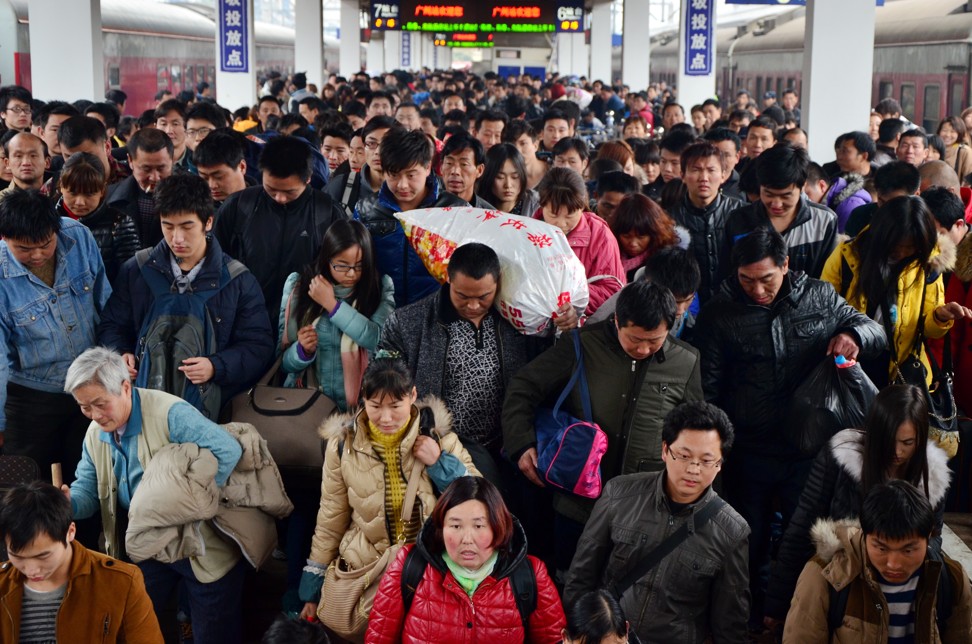
China can ease its labour shortage by giving migrant workers better access to welfare, adviser says
Beijing must provide the incentives the country’s peripatetic population needs to settle down with their families, government researcher says
Beijing must cut red tape and increase its investment in people if it wants to overcome the problems of a shrinking labour force and dwindling productivity, an eminent government researcher said.
Speaking on the sidelines of the ongoing legislative sessions in Beijing, Cai Fang, vice-president of the Chinese Academy of Social Sciences, told the South China Morning Post that one of the keys to future growth was not further fiscal stimulus, but greater freedom of movement for its workers.
The government must relax its rules on domestic migration, the country’s top economist on labour issues said.
“Our previous development relied on structural adjustments, like transferring workers out of agriculture and into high-efficiency industrial and service sectors,” Cai said.
“But given the shrinking labour force, future improvements lie in the adjustment of industrial sectors and between corporations.”
Under China’s rigid household registration system (known as hukou in Mandarin), although migrant workers can move freely from place to place, they do not have the same social and welfare benefits in host cities as they do in their hometowns. Reforming the hukou would yield immediate results, Cai said.
Under the present system, when migrant workers – of which China has about 270 million – get to the age of 40 or so, they become increasingly likely to return to their hometowns because of the difficulty in accessing education, health care and pension services, he said.
“Modernising the household registration system would reduce or even remove the likelihood of [them] returning home, ensure a net inflow of labour into cities … and improve productivity,” he said.
A dwindling labour force, coupled with increases in the minimum wage, has made Chinese workers more expensive and forced many foreign-funded manufacturing companies to either relocate to Southeast Asia or, as in the case of electronics contractor Foxconn, invest heavily in automation.
“If existing systematic obstacles remain, it is inevitable that the labour shortage will worsen and labour costs will keep rising. The replacement of human beings with robots will come early than expected,” Cai said.

Cheap labour has been a central feature of China’s economic success story over the past four decades, but times are changing, and since 2012 its annual growth rate, with the exception of a slight upturn last year, has been on a downward trend.
And after almost 40 years of strict family planning regulations, the country’s working-age population, or those aged 16 to 59, has also been in steep decline. Last year alone it fell by almost 5.5 million people to 901.99 million, according to figures from the National Bureau of Statistics.
In 2015, Beijing extended its new “two-child” policy across the country, but even that has failed to have the desired effect, with the number of births in 2017 falling by 630,000 from the previous year, the statistics agency said.
The government was also facing a problem with industrial efficiency, Cai said.
“China needs to reform investment, financing and corporate structures to improve the flow of production factors across regions and sectors,” he said.
While on one hand the government was cutting red tape to promote technical innovation and encourage start-ups, the elimination of “zombie” enterprises, mostly government-run, had barely started, he said.
“Industrial capacity and companies with low or no efficiency must be replaced,” Cai said. “Only by doing that can new growth drivers take shape.”
While there were no fears of a “hard landing” for the world’s second-largest economy – growth is expected to remain above 3 per cent, the current world average, through 2050 – that did not mean the government could rest on its laurels, the economist said.
“The danger is that you keep stimulating [the economy] and burying risks,” he said.
Cai said that he was pleased to see the government, after identifying tackling financial risk as one of its three goals for the next three years, set a lower growth target of “about 6.5 per cent” for 2018, down from the 6.9 per cent achieved last year.
“Setting a lower growth target will be useful in preventing risk,” he said.



